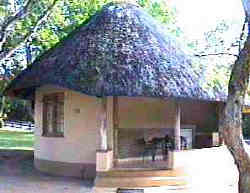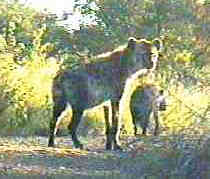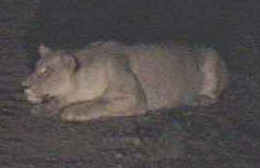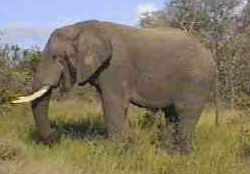The Kruger National Park, arguably South Africa’s premier tourist attraction, lies 500 kilometers (312 miles) to the east of Johannesburg, about a five hour drive through some of the most beautiful scenery in the country!
We eagerly looked forward to our one week break in the Park. We had always just popped in for the odd day visit, but this was going to be the first time that we actually stayed in the Park and experienced the atmosphere to its fullest!
We entered the Park at the Malelane gate at the southern tip of the Park. The reception staff at the gate were friendly and efficient and we were soon on our way to Skukuza, the largest camp where we were to spend the next two nights.


Equally efficient staff at Skukuza reception allocated us a bungalow; a one roomed thatched hut with bathroom and kitchenette. We noticed that all windows and doors had mosquito netting to keep the mosquitoes at bay as this was in a malaria area.
After unpacking, we scouted the camp which, apart from the accommodation, also had a cafeteria, restaurant, shop and a garage (gas station). A river runs right by the camp which is protected from the wildlife by electrified fencing.
The camp gates close at 6pm and re-open again at 6am the next morning.
We quickly got into a routine as follows.
The secret in getting the best game sightings is to start as soon as the gates open till about 10am, and then again from about 4 to 6pm when the gates close again.
In the heat of the day the animals usually lie under trees to get a bit of shade and, because of the long grass, are difficult to spot.
Speed limits in the Park are 50 kilometers per hour on tarred roads and 40 kms/hr on gravel roads. The gravel roads are good and 4X4’s are not required. All the rest camps are linked by tarred road so you don’t have to travel on the gravel roads unless perhaps you are after that special sighting!
At each camp there is a big map which indicates the sightings of the day and it is eagerly scrutinised to see where the good stuff were sighted that day! You also put up your own sightings of course!


The Park measures nearly 2 million hectares and is home to an impressive number of species: 336 trees, 49 fish, 34 amphibians, 114 reptiles, 507 birds and 147 mammals.
It therefore follows that sightings are frequent. The most common sightings are impala of which there are more the 150,000 in the Park.
So, for the duration of our stay in the Park, we were ready to hit the road at 6am every morning. Although my wife Doreen and daughter Lorraine, who are real city slickers, protested violently at having to get up so early while on holiday, the rewards of some good sightings more than justified the inconvenience.
Lorraine took over driving duties and I sat in the back seat with the cameras so I could shoot out of either the left or right window, depending on which side the game was.
We got into the habit of following another vehicle so we had more eyes available to spot game and this worked quite well. We noticed at least three giraffe carcasses right next to the road and upon asking a game ranger about this he mentioned that in the Park, giraffes were a favourite of lions.
Lions kill their prey by grabbing them by the throat and suffocating them, but because the giraffes throat is so high the lions chase the giraffe onto the roads where they slip and fall, enabling the lions to the kill them. A lion’s nostrils are slitted sideways to enable them to breathe while they are suffocating their prey.
I am a keen photographer and take photos mainly for my
website. I still need a leopard to complete my Big Five collection (elephant, lion, buffalo, rhino and leopard) and I was hoping to get a photo of the elusive animal on this trip!
We were lucky with sightings of impala, zebra, warthog, kudu, eland, jackal, giraffe (both carcass and alive!) hippo, crocodile, wildebeest as well as birdlife such as eagles, hadeda’s and the elusive fakawe bird.
This is a flightless bird with short legs that lives in long grass and in order to see where they are they jump up and down shouting “Where the fakawe!?!” (just kidding!)
Highlights of the trip were the two night game drives we went on. The park has special game viewing trucks and experienced guides. I call them walking encyclopaedias as they have a vast knowledge of anything and everything in the park and had us spellbound with their knowledge.
If we spotted something, we were to press a button in front of us that would indicate to the driver to stop. Then if we wanted the driver to back up, we had to press the button twice. We were politely reminded to press “Stop” again otherwise we would end up where we started!!
The trucks leave the camp at 5.30pm and as it is soon dark, we are handed a spotlight for each side of the truck which we then shine into the bush as the truck slowly drives along.
A telltale sign is usually a pair of bright shining eyes staring back at you; yellow eyes for the cat family and white eyes for antelope. Eyes in trees could belong to bushbabys or baboons.


We were lucky enough to spot at least five different prides of lion, which had the overseas tourists on the truck enthralled. We had a brief glimpse of my leopard before he dashed into the long grass chasing a white tailed mongoose. It was more interested in getting supper than hanging around to be photographed!!!
The drive lasts for about 3 hours and we lay awake for a long time after getting back to the camp, thinking about all the sightings we had during the day.
What a wonderful experience to lie awake listening to the animal sounds on the outside of the campÂ….the snort of a hippo in the river, the cry of a pair of hyena and the far-off roar of a lionÂ….unforgettable!!!
After two days at Skukuza we moved further north to Satara camp. This part of the Park was more grassland suited to grazers like zebra, wildebeest and impala and therefore we could expect sightings of cheetah, lion and leopard.
Although we did briefly spot a cheetah in front of us in the road, it quickly disappeared into the long grass and was gone by the time we got there, drat!!!
We had a scary moment as we drove round a bend in the road and saw this MASSIVE elephant bull walking towards us right in the middle of the road. Lorraine slammed the car into reverse and started to retreat.
No matter how much I threatened to ground her for life, she would not stop to enable me to take a photo till we were far enough away!!


When the big guy eventually turned off the road she slowly eased forward and I managed to get some good shots!
The Satara night drive was equally as exciting with more sightings of lion, elephant, hippo, hyena, the ever-present impala and some owl.
Friday arrived much too soon and we tackled the drive back to Johannesburg with fond memories of our stay in the Park.
SighÂ….I suppose I will have to wait till my next visit to get my leopard photo!!
And we will definitely be back; a visit to the Kruger Park is something that everyone must experience at least once in their lives.!!!
Park Facts and Information
There are daily flights from Johannesburg to Skukuza with car hire at Skukuza. Luxury coach tours can be arranged through tour operators.
Accommodation is available in a variety of units in larger rest camps, bushveld camps and guest lodges. Caravan and camping sites are available in most camps.
Night drives are very popular and groups are accompanied by experienced rangers. Bush drives are an educational service where trained officials take visitors to areas of the Park that are normally inaccessible to tourists.
The ultimate African experience, Wilderness Trails, sees groups of up to eight people, accompanied by armed game rangers, explore the bush on foot.
Daily rates average SA Rand 375 (about R6 to the US dollar) and are very reasonable for what is offered.
The climate is subtropical with hot summers and warm, dry winters. The night game drives can get quite chilly.
Summer rains fall between October and March. I personally feel the best time to visit the Park is between May and September when it is cooler.
Please note that when visiting the Park, Malaria prophylactics are essential.
Medication needs to be taken when you commence your visit and continued for at least 4 weeks thereafter.
General Reservations
Online Reservations
Cool Link: View wildlife from the comfort of your armchair.
Back to Africa Guide